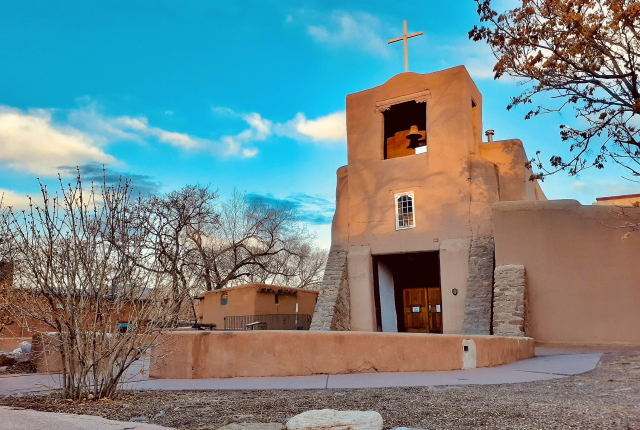LAURIANNE FIORENTINO PULLS OUT HER PHONE and calls up a photo. We’re standing in the 1710 rebuild of San Miguel Chapel, first constructed by Santa Fe’s earliest settlers around a century before then, and the church director wants to show off just how deliberately the building was designed.
“This was taken around 7 p.m., at a concert this past July,” she explains, displaying a striking image of a precise rectangle of light. It comes from the open double front doors and beams straight down the center aisle, to the altar. “Everything here is intentional.”
Famed as the oldest church in the continental United States, San Miguel’s location at the crossroads of Old Santa Fe Trail and the Camino Real is no accident. Its first iteration is said to have been built by a cohort of Indigenous Tlaxcalans from Mexico who accompanied Spanish colonists on their northward migration in the early 1600s. Designed as a community church for the soldiers, farmers, and craftspeople who settled south of the Santa Fe River, the no-frills adobe chapel exhibits the simple architectural design that came to define the missions that soon proliferated in the area.
Architect Beverley Spears, author of Early Churches of Mexico, attributes the format of chapels like San Miguel to the influence of Franciscan friars who came from parts south. She says most rural churches, beginning in the 17th century, used the same low-cost architectural model.
“Most of the New Mexico churches are just a simple, single nave, with the sacristy just off it. And all the classic, traditional adobe churches have the choir loft in the back,” says Spears, who notes that the design also required the sacristy to be oriented toward the Holy Land. “That is the normal, traditional placement for a Catholic church. San Miguel is laid out that way.”
In privately owned chapels like San Miguel, often used by families, schools, or the military, a simple form followed basic functions. (Since 1859, San Miguel has been owned by what is now St. Michael’s High School.) After the chapel was partially burned during the 1680 Pueblo Revolt, the rebuild featured an expanded, tapered sanctuary that also exemplifies the pre-Baroque model of Franciscan frontier churches.
Despite its plain appearance—a 1776 survey likened the chapel to “the granary of a hacienda”—San Miguel contains historic treasures. Two animal-hide paintings mounted on the nave represent the earliest form of religious art in New Mexico: a buffalo hide bears the image of Christ on the cross, and a deerskin painting of St. John the Baptist keeps it company. The 1798 carved-and-painted altar screen is attributed to the unnamed but hugely influential artist known as the Laguna Santero, who painted images of St. Teresa of Avila, St. Francis of Assisi, St. Gertrude of Germany, and St. Louis IX on the reredos. “In the rural New Mexican churches,” says Spears, “the real attraction and the most important element is the handmade retablo.” In that retablo’s nicho stands a statue of Archangel Michael, which was first carried through New Mexico to help solicit donations for the 1710 reconstruction.
In 1856, a 798-pound bell was added to the chapel’s tower; it is on display inside the church today. During my visit, Fiorentino shines a flashlight on the massive iron bell to reveal a tiny, mysterious Star of David etched into the surface, speculating that a Crypto-Jewish maker from Spain may have left the telltale mark.
Mass is resuming the first Sunday of each month this December. With a dynamic lineup of concerts, the chapel is often used to bestow the gift of music on its visitors. In August, San Miguel hosted a performance by Pulitzer Prize–winning composer Raven Chacon, and one docent notes that it is not uncommon for singing tourists to try out the church’s acoustics. “We can do what we want here,” says Fiorentino. “But we remain respectful to the reverence the community holds for this very old space.”
A San Miguel Story
“In relation to our parish church, this chapel is to the south, in line with it, and more than a musket shot away. It is of adobes, the walls not very thick, single-naved, 8 varas* high up to the bed molding, not quite as wide, and 23 varas long from the door to the high altar.” —Fray Francisco Atanasio Dominguez on San Miguel Chapel, writing in The Missions of New Mexico, 1776
*A vara was a unit of measure, roughly equal to 33 inches.
A Few More
Continue your exploration by visiting these historic churches.
Architect Beverley Spears calls Santa Fe’s Guadalupe Chapel, located at the larger Santuario de Nuestra Señora de Guadalupe, “a wonderful, wonderful building” that stands as a perfect model of the classic adobe cruciform, or cross-shaped, chapel. The oldest church in the country dedicated to Our Lady of Guadalupe, it is rumored to have been built around 1795. A 1783 José de Alcíbar altar screen depicting La Virgen de Guadalupe was transported, in pieces, from Mexico City via the Camino Real.
El Santuario de Chimayó, the famed monument to an annual pilgrimage site that was first used by Tewa people for its healing powers, was built in Chimayó in 1813. A timeless ode to Spanish Colonial architecture, the church features a walled courtyard, two charmingly askew pointed towers, and a metal pitched roof. (The towers and roof were added in the 1920s.) A small prayer room leads to a place called el pocito, or “the little well,” which contains a pit filled with the local “holy dirt,” said to contain healing properties.
Construction began in 1733 on the Santa Cruz de la Cañada Church, in the Villa of Santa Cruz, near Española. The church soon enjoyed a reputation as one of Spanish colonial New Mexico’s largest and most imposing places of worship. With adobe walls that stretch to four feet thick in some places, the church originally had a packed dirt floor that was replaced with wood in the 1940s.




